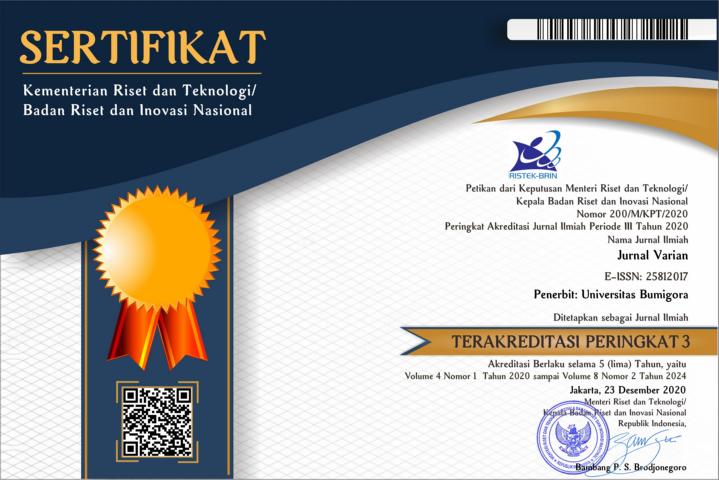Impact of SST Anomalies on Coral Reefs Damage Based on Copula Analysis
Abstract
The condition of coral reefs in Indonesia is alarming. One of the influenting factors of coral reefs damage is extreme climate change. The aim of this study is to determine the relationship of climate change, that is Sea Surface Temperature (SST) anomaly index, and coral reefs damage in West, Central and East Region of Indonesia. The method used in this study is Copula analysis. Copula is one of the statistical methods used to determine the relationship of two or more variables, in which case the distribution can be normal or not. First, data is transformed into Uniform [0,1] domain. Then, Copula parameter is estimated to get significance parameter. Lastly, the best Copula that has the highest log likelihood value is selected to represent the relationship of data. The result indicates that percentage of coral reefs damage in West and Central Region has relationship with SST Nino 4, while coral reefs damage in East Region does not have relationship with any of SST Nino anomalies. In West Region, the best Copula represents the relationship is Gaussian Copula (parameter = -0.32); it concludes that the higher the value of SST Nino 4, the lower the percentage of coral reefs damage and otherwise. While in Central Indonesia, Frank Copula (parameter = -4.89) is selected; it does not have tail dependency so that the SST Nino 4 and the percentage of coral reefs in damage condition in Central Region has low correlation.
References
Bhatti, M. I., & Do, H. Q. (2019). Recent development in copula and its applications to the energy, forestry and environmental sciences. International Journal of Hydrogen Energy, 44(36), 19453–19473. https://doi.org/10.1016/j.ijhydene.2019.06.015
Bismo, M. (2013). Perubahan Iklim Ancam Ekosistem Terumbu Karang. https://www.beritasatu.com/archive/147738/perubahan-iklim-ancam-ekosistem-terumbu-karang
Giyanto, Abrar, M., Hadi, T. A., Budiyanto, A., Hafizt, M., Salatalohy, A., & Iswari, M. Y. (2017). Status Terumbu Karang Di Indonesia 2017 (Suharsono (ed.)). Pusat Penelitian Oseanografi – Lembaga Ilmu Pengetahuan Indonesia.
He, Y., Zhang, L., Ji, J., & Zhang, X. (2019). Robust feature screening for elliptical copula regression model. Journal of Multivariate Analysis, 173, 568–582. https://doi.org/10.1016/j.jmva.2019.05.003
Hidayath, A. S. E. (2019). Analisa Struktur Dependensi Variabe Pembentukan Asuransi Pertanian Berbasis Indeks Cuaca dengan Multivariat Copula dan Vine Copula. Jurnal Varian, 3(1), 20–27. https://doi.org/10.30812/varian.v3i1.485
Li, X., & Hou, B. (2022). Correlation analysis of financial assets based on asymmetric copula. Frontiers in Applied Mathematics and Statistics, 8. https://doi.org/10.3389/fams.2022.1005956
Mashita, M., & Lumban-Gaol, J. (2019). Variability of Sea Surface Temperature (Sst) and Chlorophyll-a (Chl-a) Concentrations in the Eastern Indian Ocean During the Period 2002–2017. International Journal of Remote Sensing and Earth Sciences (IJReSES), 16(1), 55. https://doi.org/10.30536/j.ijreses.2019.v16.a3147
Metin Karakas, A., Karakas, M., & Dogan, M. (2017). Archimedean Copula Estimation Parameter with Kendall Distribution Function. Cumhuriyet Science Journal, 38(4), 619–625. https://doi.org/10.17776/csj.348292
Nafii, A., Lamane, H., Taleb, A., & El Bilali, A. (2023). An approach based on multivariate distribution and Gaussian copulas to predict groundwater quality using DNN models in a data scarce environment. MethodsX, 10(February), 102034. https://doi.org/10.1016/j.mex.2023.102034
Przyborski, P., & Levy, R. (2022). Sea Surface Temperature Anomaly. https://earthobservatory.nasa.gov/global-maps/AMSRE_SSTAn_M
Puspasari, R., Rahmadi, P., Rachmawati, P. F., & Samusamu, A. S. (2015). Sumber Daya Ikan Karang Climate Variability Interaction With Coral Reef Ecosystem and Reef Fish Resources. Jurnal Penelitian Perikanan Indonesia, 21(4), 211–220. 10.15578/jppi.21.4.2015.211-220
Speers, A. E., Besedin, E. Y., Palardy, J. E., & Moore, C. (2016). Impacts of climate change and ocean acidification on coral reef fisheries: An integrated ecological-economic model. Ecological Economics, 128, 33–43. https://doi.org/10.1016/j.ecolecon.2016.04.012
Susiloningtyas, D., Handayani, T., & Amalia, A. N. (2018). The Impact of Coral Reefs Destruction and Climate Change in Nusa Dua and Nusa Penida, Bali, Indonesia. IOP Conference Series: Earth and Environmental Science, 145(1). https://doi.org/10.1088/1755-1315/145/1/012054
Umeorah, N., Mashele, P., & Ehrhardt, M. (2019). Elliptical and archimedean copula models: An application to the price estimation of portfolio credit derivatives. Journal of Credit Risk, 17(1), 1–29. https://doi.org/10.21314/JCR.2020.263

This work is licensed under a Creative Commons Attribution 4.0 International License.


















